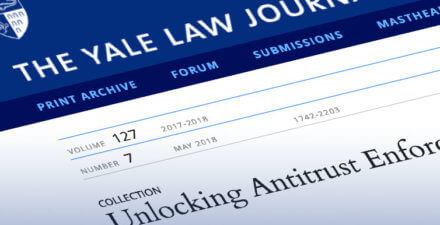Brad DeLong: Worthy reads on equitable growth, April 26–May 2, 2019
Worthy reads from Equitable Growth:
- There are lots and lots of business practices that could and should be ruled illegal restraints on trade. Read Colleen Cunningham, Florian Ederer, and Song Ma’s working paper, “Killer Acquisitions,” in which they write: “This paper argues incumbent firms may acquire innovative targets solely to discontinue the target’s innovation projects and pre-empt future competition. We call such acquisitions “killer acquisitions.” We develop a parsimonious model illustrating this phenomenon. Using pharmaceutical industry data, we show that acquired drug projects are less likely to be developed when they overlap with the acquirer’s existing product portfolio, especially when the acquirer’s market power is large due to weak competition or distant patent expiration. Conservative estimates indicate about 6 percent of acquisitions in our sample are killer acquisitions. These acquisitions disproportionately occur just below thresholds for antitrust scrutiny.”
- An event coming on May 16: Preparing for the next recession is perhaps the most productive and urgent policy analysis task today. Here are the details for “Preparing for the Next Recession: Policies to Reduce the Impact on the U.S. Economy”: “A Hamilton Project and Washington Center for Equitable Growth Policy Forum … Historically, the United States has responded to recent recessions with a mix of monetary policy action and discretionary fiscal stimulus. However, since monetary policy options may be limited during the next recession, policymakers should consider adopting a range of fiscal policy measures now to help stabilize the economy when a future downturn inevitably occurs. This can be achieved with a range of fiscal policy responses aimed at expediting the next recovery through strengthening job creation and restoring confidence to businesses and households.”
- In the real world, sometimes threats need to be exercised to move prices, and sometimes they don’t. I have high hopes that we will learn a lot about this from Antoine Arnoud’s forthcoming dissertation, “Automation Threat and Wage Bargaining.” The details can be found in this Equitable Growth 2018 grantee announcement: “One doctoral grant will support research on how economic inequality affects the quantity and quality of innovation, and whether technological innovations, in turn, impact inequality: Antoine Arnoud (Ph.D. candidate, Yale University) proposes to study a novel mechanism through which automation in the labor market might have an impact on wages through the threat, rather than the actuality, of automation.”
- Greatly looking forward to another 2018 Equitable Growth grantee research paper, “The impact of antitrust on competition.” Here is the announcement with the details: “Fiona Scott Morton (Yale University School of Management) will collect empirical metrics of antitrust enforcement outcomes to create a novel dataset, which she will use to analyze merger effects beyond prices such as employment, and to determine whether mergers in the high-tech sector are motivated by increased efficiencies or by the elimination of competitors.”
Worthy reads not from Equitable Growth:
- An impressive finding. Heartwarming. Much stronger than I thought it would be, so very nice to know. Read Barbara Biasi, “School Finance Equalisation Increases Intergenerational Mobility,” in which she writes: “Rates of intergenerational mobility vary widely across the United States. This column investigates the effects of reducing differences in revenues and expenditures across school districts within each state on students’ intergenerational income mobility, using school finance reforms passed in 20 U.S. states between 1986 and 2004. Equalization has a large effect on mobility, especially for low-income students. The effect acts through a reduction in the gap in inputs and in college attendance between low-income and high-income districts.”
- Okay, but what drives these differential rates of return, anyway? And how much can this really approach the dream of taxing luck and inheritance rather than enterprise? Read Fatih Guvenen, “Use It Or Lose It: Efficiency Gains from Wealth Taxation,” in which she writes: “When individuals differ from each other in the rate of return they earn … capital income and wealth taxes have opposite implications for efficiency, as well as for some key distributional outcomes. Under capital income taxation, entrepreneurs who are more productive … pay higher taxes. Under wealth taxation, on the other hand, entrepreneurs who have similar wealth levels pay similar taxes regardless of their productivity … A revenue-neutral tax reform that replaces capital income tax with a wealth tax raises average welfare by about 8 percent in consumption-equivalent terms … The optimal wealth tax is positive, yields larger welfare gains than the tax reform, and is preferable to optimal capital income taxes … Wealth taxes can yield both efficiency and distributional gains.”
- This is not right. Prospectively, Robert Barro was modeling a permanent supply-side boost to the level of Gross Domestic Product driven by higher investment to the tune of an extra $800 billion annually. Barro’s prospective model conclusion was not of a temporary demand-side boost. His shift to the demand side in his paper with Jason Furman was a six-month-later climb-down. I know this. He knows this. I know he knows this. He knows I know he knows this. Why bother saying this? I think the point is to fuzz the issue. Barro made three assessments: one, that the Tax Cuts and Jobs Act of 2017 would boost output by 4 percent and it might achieve its full effect in 10 years; one, that the TCJA would boost output by 7 percent with an 0.4 percent first-year effect; and one with Jason Furman that was not so much a model-based forecast of the impact, but a reduced-form claim if past correlations held. It is this last one that he now focuses on. Read Robert Barro, “My Best Growth Forecast Ever,” in which he writes: “America’s real GDP growth rate of 3.2 percent for the first quarter of this year is impressive, as was the 3 percent average growth in 2018 (measured from the fourth quarter of 2017 to the fourth quarter of 2018). Since the end of the Great Recession—from 2011 to 2017—the U.S. economy grew by only 2.1 percent per year, on average. What accounts for the recent acceleration?”
- A worthy read: “Further Thinking on the Costs and Benefits of Deficits” by Jason Furman and Lawrence H. Summers.






